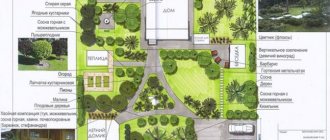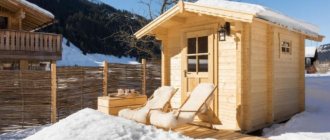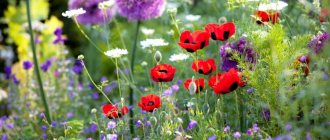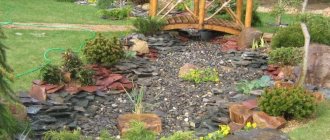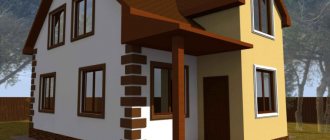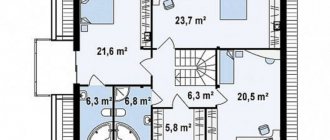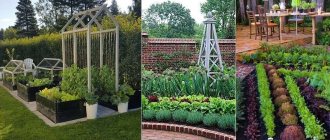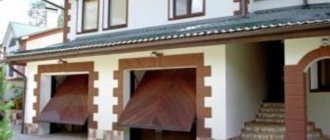Do you want your vegetable garden to become your pride? Read our article on how to do this
How to design beautiful beds for the lazy, tall and smart beds - this is what a gardener needs to know who wants to make his life as independent as possible from gardening worries. If you wish, you just need to master the method of designing lazy beds, which you can see in the following photos. A garden bed of this type will allow you to enjoy a well-deserved rest at the dacha and will not require weeding every time. In addition, it is not only convenient, but also increases crop productivity.
The easiest way to build smart beds is on a flat surface
Seedlings in a high bed always receive enough sunlight
Today there is a strong trend towards switching to healthy organic food. Classic organic farming is not very effective and is burdened with the risk of not getting a harvest at all. But smart beds are a great help in this task
Everyone knows how much time and effort needs to be devoted to each planted crop, which, however, sometimes does not even justify the result: the seedlings may not germinate or do not ultimately produce a normal amount of harvest. In this case, you should pay attention to the technology of lazy beds on your site!
Multi-level narrow beds and paths sprinkled with pebbles
Small beds you can make yourself with a minimum of tools
Planning
First you need to decide on the simplest thing - how many square meters do you want to allocate for the future vegetable garden?
The standard solution is to allocate about three to four acres, but here different options are possible, which depend on:
- on the number of family members;
- area of the site;
- availability of sufficiently lit space;
- the desire of the owners to arrange other useful and beautiful things on the site such as flower beds, gardens, gazebos, greenhouses, garden decorative sculptures, etc.
So it turns out that the layout of a vegetable garden at a summer cottage depends not only on the number of acres, but also on the desires and capabilities of family members.
Choosing wood for boards
For a good garden bed, it is better to use boards that are resistant to moisture and rot, and can last for more than one season. It should also be taken into account that not all types of wood are suitable for construction, so the choice should be approached as carefully as possible.
The following types of wood are suitable for timber beds:
- Ash and oak boards, which have a high level of strength, are resistant to rotting and other external negative factors. But the cost of such a design will be quite high.
- The cheapest option is to use pine boards. But they require additional protection from moisture, rot and mold. In this case, not all impregnations can be used, since most of them are not environmentally friendly.
- An excellent option is to use coniferous species, among which larch and cedar stand out. They are well protected from negative external phenomena, and at the same time they are not as expensive as oak boards.
- Among the good options for arranging beds is acacia. Solid and durable wood can last for several seasons, providing optimal conditions for growing a variety of crops.
It should be taken into account that not only edged boards are suitable for constructing beds, but also lining and wooden panels. The choice is based on the requirements for the height of the structure, the thickness of its wall and other parameters. The simplest and most affordable option is a board, but if you don’t have one, you can use other available means.
Start
Never try to do everything at once. Don’t be afraid to start small - a successful start will give you confidence in your abilities and increase motivation for further work.
In the first year of gardening, we recommend planting radishes, cucumbers, onions, and sowing lettuce seeds. It seems like a simple set, but it’s quite enough for preparing salads, and it won’t take a lot of time and effort to work in the garden.
Advice! Don't try to grow tomatoes and strawberries the first year! These are capricious crops that require careful care and certain skills.
Paths
The paths between the beds should not be overgrown with weeds and take a lot of time to weed; it is better to cover them. There are various options for equipping paths - turfing with lawn grass that is resistant to trampling, covering with tiles, gravel, and broken bricks.
To prevent weeds from growing through them, first you need to lay geotextiles or roofing felt that does not transmit light on the paths, and then crushed stone, gravel, stone chips, and other material on top of it.
There are various ready-made slabs for garden paths on sale - rubber, plastic, or special roll coverings. Another option is a covering made from plastic bottle caps, which can also serve as a massage mat.
Aesthetics
As the great Faina Ravnevskaya said, “Beauty is a terrible power!” It's hard to disagree with this. We must try to “kill two birds with one stone” - get healthy and necessary products, and please the eye with the beautiful design of the site.
The right design style will help you achieve such harmony: minimalist or French.
Let's talk about the features of these stylistic trends in more detail.
Monastery courtyard
Proponents of minimalism choose simple, clear geometric shapes to decorate their garden. For such people, a rectangular garden layout is perfect.
Straight lines combine beautifully with geometric shapes, and cobblestone paths not only attract the eye with their simple beauty, but also provide convenient access to the beds.
Note!
Trellis for grapes? do it yourself - ready-made solutions for the garden plot. Instructions + 120 photos of options for the correct trellis
The best ideas for a summer cottage: 110 photos of exclusive ideas and new products in landscape design at a summer cottage
House for a well: a step-by-step master class on how to make it yourself, recommendations from craftsmen with simple work patterns
Another advantage of the ascetic design is that there is room for a small pond, miniature benches and low-growing bushes.
French charm
Would you like to have something similar to the design of the royal Versailles from the time of the Sun King? Then you’ll have to start arranging your site in the French style!
It should be remembered that you will have to determine the central part of the composition, from which triangular beds will extend, forming a hemisphere or semicircle. Symmetry must be observed when designing each element.
More detailed information on how to plan an exquisite vegetable garden can be easily found on the Internet. We will list those elements that will decorate a suburban area in general, and a vegetable garden in particular:
- decorative borders of paved paths;
- miniature fountain;
- curly (topiary) bush trimming;
- garden sculptures.
Important! Low-growing shrubs are suitable for such a garden. They should not “obstruct” the view, and from time to time they “demand” a fashionable “hairstyle”.
Note!
- Do-it-yourself canopy over the porch - choice of materials, types of structures + instructions for making it yourself
Do-it-yourself bathhouse in the country: expert recommendations, choice of materials, step-by-step description + instructions for DIY construction
How to sew outdoor curtains for a gazebo with your own hands: step-by-step instructions + 140 photos of ready-made ideas
Plastic structures
Products made from polymer elements favorably emphasize the perimeter of plantings. In addition, plastic beds come in different colors and textures, so you can create a unique landscape design.
Plastic is a fairly rigid barrier, which subsequently separates the landing zone.
The plastic elements are flexible enough to give the structure any shape.
Due to the fact that plastic beds do not absorb moisture and are not affected by temperature changes and direct sunlight, they can be collected in different climatic zones.
In the courtyard
The garden plastic board used can be of different textures:
- brick;
- natural stone;
- wood texture;
- metal and much more.
It must be admitted that beds made of PVC boards are much more durable than those made of lumber. They are reliably protected from rotting.
Also, if desired, the plastic box can be moved from place to place, which cannot be done when the structure is stone, brick or iron. In fact, plastic fences are mobile structures that do not require specific maintenance.
Design diagram
In addition to the above advantages, plastic parts have the following features:
- Simple and relatively quick installation. Using plastic elements for the garden bed, you will eventually be able to assemble a box in the shortest possible time. The plastic does not need to be further processed or placed on a bonding material. You just need to create a configuration of a suitable shape, and then fill it with fertile soil.
- Polyvinyl chloride is characterized by increased wear resistance and practicality. Structures made from this material are designed for a fairly long service life. Moreover, polyvinyl chloride is a lightweight material, which makes it possible to design multi-tiered country houses. If you make beds for strawberries, tomatoes or cucumbers from polyvinyl chloride with your own hands, then this will be an excellent solution.
- A huge selection of plastic models and excellent decorative qualities. You can choose elements of different textures, which will allow you to decorate your summer cottage and give it a zest.
- Mobility. If desired, decorative composite fencing can be quickly and easily dismantled or moved. There is corresponding video material on this topic on YouTube.
- No additional care. Unlike the same wood box, a PVC border does not require special processing. Over time, it does not need to be varnished or painted, since PVC does not absorb moisture and does not deteriorate when exposed to direct sunlight.
Options for wooden borders
Rules for the location of beds
To get the maximum harvest, you need to properly arrange your garden at your dacha, and for this you must adhere to the following rules:
- choose the sunniest place - all vegetable crops love warmth and the rays of daylight;
- Before sowing or planting, the soil should be leveled;
- if the soil has a slope, then plants should be planted across it (slope), thereby increasing the efficiency of irrigation;
- try to keep the beds the same length (three to four meters) and width (up to 45 centimeters).
Important! Symmetry always improves visual perception and allows for free access to the cultivated area. Do not arrange beds between fruit trees under any circumstances - the shade will not allow you to get a good harvest, and besides, the chemicals that are used to treat the fruit trees may get into the vegetables!
Examples of the best flower beds for a summer residence
As they say, it is better to see once than to read five times. Therefore, let's look at the most successfully implemented flower beds. Maybe you will like some ideas and you can implement them at your dacha.
Neighbor Compatibility
It is not only individual people who cannot find a common language among themselves and accumulate grievances against each other. It must be taken into account that the same thing happens among vegetables! You should adhere to certain rules in order to correctly plan the planting of vegetable crops in the beds and not cause hostility between garden partners. So, next door you can place:
- beans that will repel beetles from eggplants and fleas from cabbage;
- peas get along well with carrots and turnips;
- onions “make friends” with lettuce, cucumber, carrots and Brussels sprouts;
- cucumbers have nothing against being next to white cabbage, corn, dill and garlic;
- parsley will give a good harvest in the company of basil, onions, cucumbers, beans, asparagus and tomatoes.
This is interesting! Most garden crops experience something like an allergy to one or another neighbor, but peppers, pumpkin, asparagus, lettuce, mustard, zucchini, leeks, squash, horseradish, have a very “flexible” character and do not have incompatible plants.
Useful ideas
To make plants feel comfortable in such beautiful, original beds and to reap good harvests, you can use some secret little things. However, little things help a lot in caring for the garden and growing your favorite plants:
- It is good to add hydrogel to the soil of vertical beds - it will not dry out quickly, but will retain moisture longer
- It is useful to plant marigolds, nasturtiums and other neighboring flowers next to vegetables, which naturally protect other plants from pests
- If suddenly there are ants in the beds, you can plant a celandine bush directly into the anthill - the ants will leave
- It’s good to put a net on the bottom of the box beds - moles won’t spoil the plantings
- After harvesting vegetables, it’s good to immediately sow green manure in the beds
- mustard – quickly produces green mass, disinfects the soil, gets rid of wireworms, supplies nitrogen, phosphorus, potassium
- rapeseed - structures and loosens the soil, which helps plant roots breathe and increases moisture capacity
- lupine - gives a lot of green mass, enriches the soil with nitrogen, loosens the soil, repels the larvae of the May beetle, mole cricket and other soil pests with its roots
- vetch and oats enrich the soil with nitrogen and potassium
- next to vegetables, you can plant honey plants in the beds (white clover, coltsfoot, lungwort, mint, lemon balm, borage, phacelia), which will attract bees, which will ensure pollination of flowers to increase the yield
- the mole cricket does not like parsley, marigolds, or calendula; by planting them around the perimeter, you can protect your garden
Organization of watering
In addition to soil composition and good lighting, vegetable crops need moisture. Depending on the region where the summer cottage is located, care must be taken to properly organize the irrigation of the garden.
There must be a water reserve on the site - a water supply system, a well, barrels of water.
You can choose the watering method according to your taste - using a hose or a drip irrigation system.
Important! The presence of groundwater near the surface (a little more than half a meter) will require the design of a drainage system to remove excess moisture.
